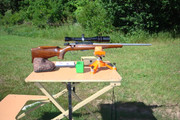My experience with rifle scopes is to secure the base and rings to the receiver and then secure the scope into the rings. There is no sim adjustment. It's as if there is an average height given people's various neck length and head shape. At the bench, I have to lower my line of sight to the rings, observe the shading of the rim, draw back and make sure there is now shadow on the edges as I move forward and hold the stock. I don't know if there's a better technique.
That said, shooting from the standing and sitting position must be similar. Do you adjust the scope with shims.. so when you shoulder your rifle, the scope falls into full vision as you anchor a certain part of your face to the stock? Maybe you'll have to learn to lower your line of sight by leaning forward and into the rifle than twisting your neck? If you don't adjust the scope, do you adjust your butt plate? My field shooting has been with open sights.
That said, shooting from the standing and sitting position must be similar. Do you adjust the scope with shims.. so when you shoulder your rifle, the scope falls into full vision as you anchor a certain part of your face to the stock? Maybe you'll have to learn to lower your line of sight by leaning forward and into the rifle than twisting your neck? If you don't adjust the scope, do you adjust your butt plate? My field shooting has been with open sights.

